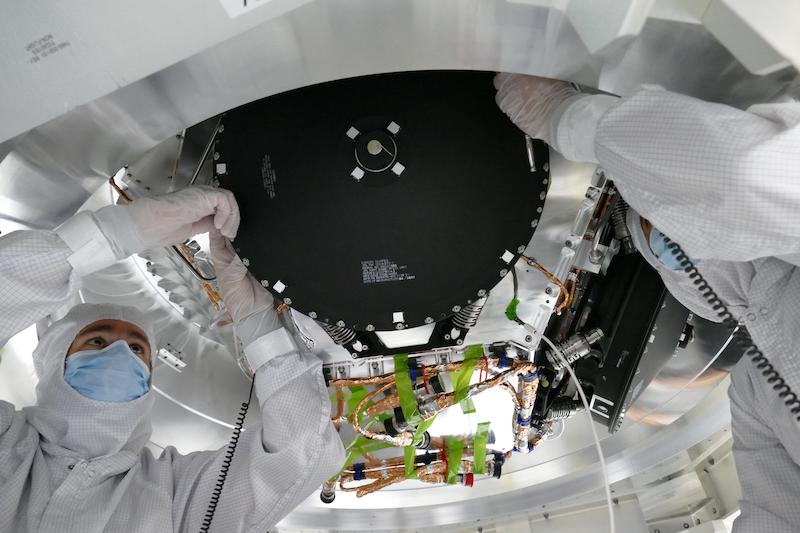
NASA just took another big step forward in its Europa Clipper mission. NASA’s Jet Propulsion Laboratory (JPL) reported on November 23, 2022, that engineers have installed four large reaction wheels in the spacecraft. These reaction wheels are crucial for keeping the spacecraft oriented properly while traveling in space. Europa Clipper is an exciting mission. It will study and assess the habitability of Jupiter’s moon Europa, the famous one with the subsurface ocean. Scientists say that Europa’s inner ocean is likely similar to Earth’s oceans and could be quite suitable for life of some kind.
Europa Clipper gets its wheels for journey to Europa
Although Europa Clipper will be flying through space, it still needs wheels for its journey. Why? While other vehicles use wheels for traveling on roads, Europa Clipper’s “wheels” are different. They’re used for keeping the spacecraft oriented properly and pointed in the right direction.
When Europa Clipper reaches Jupiter, it will go into orbit around the giant planet. Then, it will perform repeated close flybys of Europa. The wheels help to rotate the orbiter. This keeps the science instruments oriented properly and allows its antennas to communicate back to Earth.
Isaac Newton’s third law of motion
The rapidly spinning wheels create a rotational force called torque that causes the spacecraft to rotate in the opposite direction. Basically, the spacecraft is reacting to the spinning movement of the wheels. This is also a good display of Isaac Newton’s third law of motion: For every action, there is an equal and opposite reaction. Or, more specifically: If two bodies exert forces on each other, these forces have the same magnitude but opposite directions.
So, if the motor of a wheel accelerates the wheel in one particular direction, the spacecraft will then accelerate in the opposite direction.

Why not use thrusters on Europa Clipper?
You may wonder why Europa Clipper doesn’t just use thrusters to maneuver. The answer, simply, is fuel. Thrusters need fuel, of which there is a limited supply onboard the spacecraft. The reaction wheels, however, use electricity from the spacecraft’s solar panels. This is especially necessary since Europa Clipper will be making thousands of turns, called slews, while conducting its flybys of Europa. The slews allow the spacecraft to be able to perform its science investigations of Europa.
The only downside is that the wheels turn very slowly, about three times slower than the minute hand on a clock. In fact, it will take about 90 minutes for Europa Clipper to turn 180 degrees. What’s that saying about watching paint dry?
Also, like any mechanical device, the wheels will gradually wear out. NASA anticipated this, of course. That’s why they installed four wheels, when only three are needed. Kind of like having a spare tire for an earthly road trip. To even out the wear and tear, the engineers alternate which wheels they’re using at any given time.
Exploring an ocean world
Set to launch in 2024, Europa Clipper will reach Jupiter in 2030. It’s designed specifically to study Jupiter’s moon Europa, and it will conduct repeated close flybys of the moon. Europa is the most well-known of the ocean moons, with a deep water ocean beneath its icy outer crust. NASA wants to investigate this ocean world in much more detail than previously possible.
Europa Clipper will search for evidence that the ocean is indeed habitable (or not, but scientists say it likely is). It will use nine science instruments to analyze both the ocean and the surface of Europa. It will also search for Europa’s elusive water vapor plumes.
Could Europa really be home to alien life of some kind? Europa Clipper will be the first mission dedicated to help answer that fascinating question.
Bottom line: NASA engineers and technicians have installed four reaction wheels on Europa Clipper. They will keep the spacecraft oriented as it explores Jupiter’s ocean moon.











